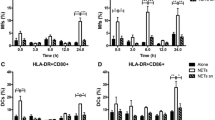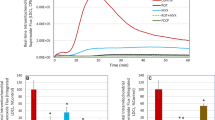Abstract
Background
Using specific antibodies against bovine Cu/Zn-superoxide dismutase (EC 1.15.1.1, SOD1) we demonstrated that anti-SOD antibodies (IgG1) are able to promote the intracellular translocation of the antioxidant enzyme. The transduction signalling mediated by IgG1 immune complexes are known to promote a concomitant production of superoxide and nitric oxide leading to the production of peroxynitrites and cell death by apoptosis. The Fc-mediated intracellular delivery of SOD1 thus limited the endogenous production of superoxide. It was thus of interest to confirm that in the absence of superoxide anion, the production of nitric oxide protected cells against apoptosis. Study in greater detail clearly stated that under superoxide anion-free conditions, nitric oxide promoted the cell antioxidant armature and thus protected cells against redox-induced apoptosis.
Materials and Methods
The murine macrophage cell-lines J774 A1 were preactivated or not with interferon-γ and were then stimulated by IgG1 immune complexes (IC), free SOD1 or SOD1 IC and superoxide anion, nitric oxide, peroxynitrite, and tumor necrosis factor-α (TNF-α) production was evaluated. The redox consequences of these activation processes were also evaluated on mitochondrial respiration and apoptosis as well as on the controlled expression of the cellular antioxidant armature.
Results
We demonstrated that SOD1 IC induced a Fcγ receptor (FcγR)-dependent intracellular delivery of the antioxidant enzyme in IFN-γ activated murine macrophages (the J774 A1 cell line). The concomitant stimulation of the FcγR and the translocation of the SOD1 in the cytoplasm of IFN-γ-activated macrophages not only reduced the production of superoxide anion but also induced the expression of the inducible form of nitric oxide synthase (iNOS) and the related NO production. This inducing effect in the absence of superoxide anion production reduced mitochondrial damages and cell death by apoptosis and promoted the intracellular antioxidant armature.
Conclusions
To define the pharmacologic mechanism of action of bovine SOD1, we attempted to identify the second messengers that are induced by SOD1 IC. In this work, we propose that Fc-mediated intracellular delivery of the SOD1 that reduced the production of superoxide anion and of peroxynitrite, promoted a NO-induced protective effect in inducing the antioxidant armature of the cells. Taken together, these data suggested that specific immune responses against antigenic SOD1 could promote the pharmacological properties of the antioxidant enzyme likely via a NO-dependent mechanism.








Similar content being viewed by others
References
McCord JM, Fridovich I. (1969) Superoxide dismutase: an enzymatic function for erythrocuprein (hemocuprein). J. Biol. Chem. 244: 6049–6055.
Zimmerman JJ (1991) Therapeutic application of oxygen radical scavengers. Chest 100: 189S–192S.
Jadot G, Vaille A, Maldonado J, Vanelle P. (1995) Clin. Pharmacokinet. 28: 17–25.
Ouaaz F, Ruscetti FW, Dugas B, Mikovitz J, Agut M, Debré P, and Mossalayi MD. (1996) Biphasic effects of IgE-immune complexes on HIV-1 + monocytic U1 cell line: involvement of CD23/FcεRII transduction signals. Mol. Med. 2: 38–48.
Schwartz KB. (1996) Oxidative stress during viral infection: a review. Free Rad Biol Med. 21: 641–649.
Harris ED. (1992) Regulation of antioxidant enzymes. FASEB J. 6: 2675–2683.
Vaille A, Jadot G, Elizagaray A. (1990) Anti-inflammatory activity of various superoxide dismutase on polyarthritis in the Lewis rat. Biochem. Pharmacol. 39: 247–255.
Lund-Olesen K, Memander KB. (1974) Orgotein: a new anti-inflammatory metalloprotein drug preliminary evaluation of clinical efficacy and safety in degenerative joint disease. Curr. Ther. Res. 16: 706–717.
Marklund SL. (1980) Distribution of Cu/Zn-superoxide dismutase and Mn superoxide dismutase in human tissues and extracellular fluids. Acta Physiologica. Scand. 492: 19–23.
Michelson AM, Jadot G, Puget K. (1987) Mechanism of anti-inflammatory activity of superoxide dismutases. In: Hayashi O, Imamura I, Miyachi Y (eds.) The Biological Role of Reactive Oxygen Species in Skin. University of Tokyo Press, Tokyo, pp. 199–210.
Mozaffarian N, Berman JW, Casadevall A. (1995) Immune complexes increase nitric oxide production by interferon-gamma-stimulated murine macrophage-like J774.16 cells. J. Leukoc. Biol. 57: 657–662.
Muto S, Sumai K, Inage Y, Matsumoto K, Yuki I. (1996) Nitric oxide and immune complexes are involved in the induction of a novel luminol chemiluminescence in cytotoxic macrophages. Biol. Pharm. Bull. 19: 1521–1523.
Markey BA, Phan SH, Varani J, Ryan US, Ward PA. (1990) Inhibition of cytotoxicity by intracellular superoxide dismutase supplementation. Free Rad. Biol. Med. 9: 307–314.
Kolb JP, Paul-Eugène N, Abadie A, Yamaoka K, Drapier JC, Dugas B. (1994) IL-4-stimulates cGMP production in normal IFN-γ-activated human monocytes. Involvement of the NOsynthase pathway. J. Biol. Chem. 269: 9811–9819.
Mossalayi AM, Paul-Eugène N, Ouaaz F, et al. (1994) CD23-ligation by IgE induces the release of pro-inflammatory mediators from human monocytes through an L-arginine-dependent pathway. Int. Immunol. 6: 931–935.
Kooy NW, Royall JA, Ischiropoulos H, Beckman JS. (1994) Peroxynitrite-mediated oxidation of dihydrorhodamine 123. Free Rad. Biol. Med. 16: 149–156.
Wong GH, Elwell JH, Oberley LW, Goeddel DV. (1989) Manganous superoxide dismutase is essential for cellular resistance to cytoxicity of tumor necrosis factor. Cell 58: 923–931.
Lowry OH, Resebrough NJ, Farr AL, Randall RJ. (1951) Protein measurement with the Folin phenol reagent. J. Biol. Chem. 193: 265–275.
Vouldoukis I, Riveros-Moreno V, Dugas B, et al. (1995) IgE induces Leishmania major killing by human macrophages: a role for FcεRII/CD23-mediated stimulation of nitric oxide pathway. Proc. Natl. Acad. Sci. USA 92: 7804–7811.
Dugas N, Mossalayi MD, Calenda A, et al. (1996) Nitric oxide involvement in the antitumoral effect of retinoic acid and 1,25-dihydro-xyvitamin D3 on human promonocytic leukemic cells. Blood 80: 804–812.
Xie QW, Cho HJ, Calaycay J, et al. (1992) Cloning and characterization of inducible nitric oxide synthase from mouse macrophages. Science 256: 225–228.
Szabo C, Day BJ, Slazman A. (1996) Evaluation of the relative contribution of nitric oxide and peroxynitrite to the suppression of mitochondrial respiration in immunostimulated macrophages using a manganese mesoporphyrin superoxide dismutase mimetic and peroxynitrite scavenger. FEBS Lett. 381: 82–86.
Zhao H, Dugas N, Mathiot C, et al. (1998) B-cell chronic lymphocytic leukemia cells express a functional inducible nitric oxide synthase displaying anti-apoptotic activity. Blood 92: 1031–1038.
Yokozawa T, Chung HY, He LQ, Oura H. (1996) Effectiveness of green tea tannin on rats with chronic rat failure. Biosci. Biotech. Biochem. 60: 1000–1005.
Sandstrom PA, Tebbey PW, Van Cleave S, Buttke T. (1994) Lipid hydroperoxydes induce apoptosis in T cells displaying a HIV-associated glutathione peroxydase deficiency. J. Biol. Chem. 14: 798–801.
Gross A, Dugas N, Spiesser S, et al. (1998) Nitric oxide production in human macrophagic cells phagocytizing opsonized zymozan: direct characterization by measurement of the luminol dependent chemiluminescence. Free Rad. Res. 28: 179–185.
Ischiropoulos H, Zhu L, Beckman JS. (1992) Peroxynitrite formation from macrophage-derived nitric oxide. Arch. Biochem. Biophys. 298: 446–451.
Komorev EA, Kennedy MC, Kalyanaraman B. (1999) Cell-permeable superoxide dismutase and gluthatione peroxidase mimetics afford superior protection against doxorubicin-induced cardiotoxicity: the role of reactive oxygen and nitrogen intermediates. Arch. Biochem. Biophys. 368: 421–428.
Winyard PG, Blake DR. (1997) Antioxidants, redox-regulated transcription factors, and inflammation. Adv. Pharmacol. 38: 403–421.
Kroemer G, Petit P, Zamzami N, Vayssières JL, Mignotte B. (1995) The biochemistry of programmed cell death. FASEB J. 9: 1277–1287.
Lander HM. (1997) An essential role for free radicals and derived species in signal transduction. FASEB J. 11: 118–124.
Regnault C, Soursac M, Roch-Arveiller M, Postaire E, Hazebroucq G. (1996) Pharmacokinetics of superoxide dismutase in rats after oral administration. Biopharmaceutics Drug Disposition 17: 165–174.
Dugas B, Mossalayi MD, Damais D, Kolb JP. (1995) Nitric oxide production by human monocytes/macrophages: evidence for a role of CD23. Immunol. Today 16: 574–581.
Marcinkiewicz J, Grabowska A, Chain B. (1995) Nitric oxide up-regulate the release of inflammatory mediators by mouse macrophages. Eur. J. Immunol. 25: 947–951.
Albina JE, Cui S, Mateo RB, Reichner JS. (1993) Nitric oxide-mediated apoptosis in murine peritoneal macrophages. J. Immunol. 150: 5080–5085.
Harrison J, Shi X, Wang L, Ma JK, Rojanasakul Y. (1994) Novel delivery of antioxidant enzyme catalase to alveolar macrophages by Fc receptor-mediated endocytosis. Pharm. Res. 11: 1110–1114.
Brown DR, Schmidt B, Kretzschmar HA. (1996) Role of microglia and host prion protein in neurotoxicity of a prion protein fragment. Nature 380: 345–347.
Brown P. (1996) Bovine spongiform encephalopathy and Creutzfeldt-Jakob disease. Brit. J. Med. 312: 790–791.
Author information
Authors and Affiliations
Corresponding author
Rights and permissions
About this article
Cite this article
Vouldoukis, I., Sivan, V., Vozenin, M.C. et al. Fc-Receptor-Mediated Intracellular Delivery of Cu/Zn-superoxide Dismutase (SOD1) Protects Against Redox-Induced Apoptosis Through a Nitric Oxide Dependent Mechanism. Mol Med 6, 1042–1053 (2000). https://doi.org/10.1007/BF03402055
Accepted:
Published:
Issue Date:
DOI: https://doi.org/10.1007/BF03402055




